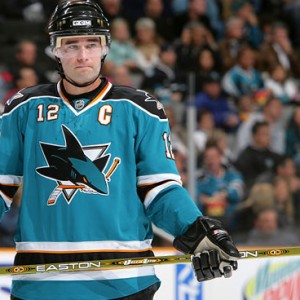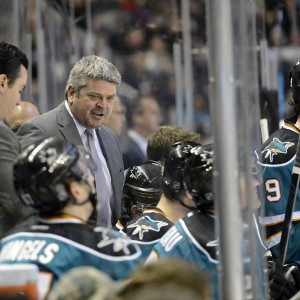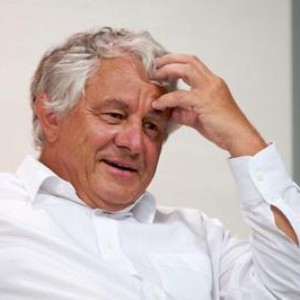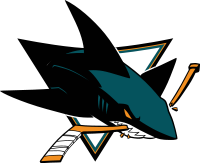This season will be the 25th for the San Jose Sharks. Well, sort of. Measuring the years and the dates gets a bit clumsy, as the NHL missed a season. For the record, the Sharks’ initial season came in 1991-92, with the team playing games in the unimpressive San Francisco venue known as the Cow Palace. So while this will be the 24th season the Sharks play hockey, it’ll be their 25th as a franchise counting the season they didn’t play. Good enough to put on a jersey patch and fire up some celebratory events and promotions.
And why not celebrate? This is not some modest milestone; it is absolutely worthy of celebration.
The Beginning
Getting hockey to San Jose was, to some degree, a chicken and egg scenario that played out beginning in the late 1980s. It would be tough to get a major sports team to San Jose without a venue. But officials and citizens of San Jose were reluctant to support a venue without a commitment from a major sports team — an anchor tenant. “Build it and they will come” was uncertain. The converse, however, was more clear: don’t build it and they won’t come.
While there was interest from a couple of NHL franchises, no commitment had been reached when the voters of San Jose narrowly approved the venue in June 1988. With firmer commitments and some clever deal-making on the part of Minnesota North Stars owner George Gund, the Sharks were spun out of the North Stars. That formal commitment came in 1990. The relationship between an owner and a fan base is often complex and controversial. This was not the case with the Sharks’ original owner. Gund became owner of the Sharks in the deal. His hockey roots in the Bay Area ran deep, back to the Seals when they played in Oakland. Gund was determined to bring hockey back to the area, but there was ample reason to believe this was a major gamble. Hockey had struggled in the Bay Area before. San Jose had essentially no hockey in its past and it was far from certain that an NHL team could succeed in a market with other high-profile professional teams in nearby Oakland and San Francisco. Gund took the risk, made it work and was widely appreciated. He passed away in 2013, and he will be among those deservedly honored this season.
The story of the venue and the Sharks are intertwined, but it has been a wonderfully symbiotic relationship. San Jose’s downtown was about as backwater as it gets for a major city when the voters cast their ballots on whether to build the arena. Various attempts at downtown revitalization failed or underachieved (a cynic might question the term ‘revitalized,’ which implies downtown San Jose was ever ‘vitalized’ prior to the arena). The Shark Tank marked a decisive turning point.
The largest city in the US without an NHL or NBA team is San Diego. Now can you name the main venue there? The San Diego arena owners claim the venue sees an annual attendance of 600,000. The Sharks regular season attendance alone is roughly 700,000. It is fair to say that the Sharks brought life to the Shark Tank, that combination helped bring life to downtown San Jose.
A Bigger Picture Emerges
With an anchor tenant in place, the Shark Tank was built. It was originally called the San Jose Arena, ready for the 1993-94 season. It quickly became the top quality indoor venue in the Bay Area, passing the arena in Oakland and the Cow Palace. An anchor tenant has enabled the venue to be well-maintained and periodically upgraded. A well-maintained venue has helped the arena management to book major acts over the years, from Barbra Streisand to Miley Cyrus. From Andrea Bocelli to Oprah, the arena has seen plenty of large crowds. This past week, it hosted Indian Prime Minister Narendra Modi and 18,000 people showed up for this sold-out event. These crowds have been a boon to the city’s downtown, located a few minute stroll away. With businesses now able to count on crowds for about 100 nights a year, investment followed and downtown became a ‘go-to’ place. It should also be noted, when the NHL has had lockouts, downtown businesses suffered.

The Shark Tank has hosted numerous sporting events. The Harlem Globetrotters show up annually. The US Olympic trials in gymnastics has been at the Shark Tank and will be again in 2016. Olympic figure skating qualifiers also took place there. Teams that have called the venue home range from lacrosse (Stealth) to women’s basketball (Lasers) to roller hockey (Rhinos). The current Arena Football League champions are the San Jose SaberCats (winning the Arena Bowl over a team nicknamed the Sharks). The SaberCats drew an average of over 9,000 fans per game. The newest team to use the venue will be the San Jose Barracuda, the Sharks’ minor league affiliate. A tennis tournament, boxing and wrestling have all been part of the history in San Jose.
How much of this happens without an anchor tenant is an open question.
Perhaps the worst thing that can be said about the Shark Tank is its series of unfortunate names. Corporations that put their name on the venue include Hewlett-Packard and Compaq. Currently, it is the SAP Center. No one has informed the landlords that they’d be wise to work with what the locals call it, the Shark Tank. Which nicely dovetails with and promotes the main tenant.
Challenges Remain

The Sharks have had challenges over the years and while many see the playoff disappointments as the main problem, I see it differently. The Sharks fan base has been loyal, but it doesn’t have the depth needed in the community, especially one the size of San Jose. Selling out hockey games in a city that is 10th largest in the USA and among the nation’s richest should be no problem. But last year, it was. For years, the joke has been to look around the venue and guess the announced attendance figure. Sure enough, 17,562, a sellout. Even with plenty of empty seats. The issue goes deeper. In many of the Sharks’ early playoff years, fans would line up outside the Shark Tank for playoff tickets, the vast majority would go away without. In recent years, chunks of empty seats have been seen at playoff games (including about a dozen right in front of where I sat one year). Sold but unused tickets were a rarity in years past, more common now. Perhaps it is the abundance of options, perhaps making the playoffs is just less special. Certainly success for other Bay Area sports teams has kept the Sharks off the front pages, even in San Jose. The San Francisco 49ers went to a Super Bowl, the Giants have won three World Series in recent years and the current NBA Champs reside in in Oakland. Some might suggest that Levi’s Stadium, the new home to the 49ers in nearby Santa Clara, has had an impact. Perhaps so, but many of these issues had been cropping up prior to the opening of the new stadium.
The Sharks must do a better job of connecting with the community. Sports teams build up their base over decades. For the Sharks at 25 (22+ in San Jose), it remains a work in progress.
The Owner Steps Up

A major announcement, and one of the rare public appearances by owner Hasso Plattner came after the season ended. He announced a long-term extension for the Sharks to play in the Shark Tank. Importantly, it came not at a high point in the Sharks history, but at a low point in recent years. The team had failed to make the playoffs, its home sellout streak had ended. For the first time since the building of the Shark Tank back in the early 1990s, a major new venue was being designed in the Bay Area, in San Francisco for the Warriors basketball team. The success of venues with both NHL and NBA tenants is compelling. If there was ever a time for Plattner to consider a shorter-term lease and a potential move to a new venue in San Francisco, this was it. Yet, Plattner not only chose to stay in San Jose, he praised the facility. Despite having plenty of negotiating leverage, Plattner refreshingly made only modest demands on the city. For all the grumbling of Sharks fans about this past season, Plattner’s announcement was a major positive development.
A Broad and Positive Impact
It has to be noted that the Sharks impact has stretched beyond just the downtown. The Sharks Foundation is respected in the community, players current and retired are frequently seen at public events such as book drives and playground refurbishings. Also worth noting is the growth of Sharks Ice, the teams practice facility, with its four ice sheets. It is a facility that bills itself as “largest rink facility west of the Mississippi.” Sharks Ice veterans include 2014 US Olympic figure skater Polina Edmunds.
Many Sharks fans bemoan the lack of a Stanley Cup, as if that is the sole measure by which to judge a franchise. Looking at what the Sharks have meant to the area, the glass isn’t half full, its brimming over.
Nothing is guaranteed forever, but the Sharks have built a meaningful presence in San Jose. A good foundation is in place, but there is still much to improve. San Francisco, less than 50 miles to the north, remains the dominant city in the Bay Area. When the new Warriors facility is built, there will be increased competition for a variety of major events. This competition could lessen the ability to maintain the San Jose arena and create risks down the road. Still, the roots the Sharks have put down in this area, the success of the arena and the backing of ownership suggests that San Jose can stand strong for the long run.
The relationship between the team, the city and the fan base means this: the future for the Sharks in San Jose remains bright. The Sharks have helped San Jose not just to grow, but to grow up. Even without the sort of playoff success Shark fans crave, there is simply no denying the force for good that the Sharks have been for San Jose. This anniversary is absolutely worth celebrating.
